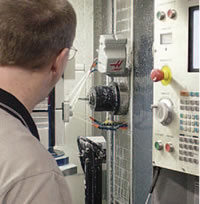
Microscopic organisms (microbes) such as bacteria and fungus are present in our bodies, our skin, the air we breathe and the water we drink. The vast majority of these microbes are not pathogens (disease causing) and therefore do not cause problems in metalworking coolants. However, some microbes are ideally suited for life in the warm, damp, dark environment of a coolant sump.
Bacteria are actually microscopic, one-celled animals. Fungus, mold and yeasts make up the plant microbes. Each has its own characteristic and favorite conditions for growth. Of the two, bacteria are relatively easy to control.
Once inside a system, fungus, yeast and mold can be very difficult to treat. Since bacteria and fungus compete for the same food sources, a healthy population of bacteria keeps the growth of fungus under control.
The uncontrolled growth of microbes can lead to problems such as odors, plug lines, corrosion and coolant emulsion instability. A clean, uncontaminated sump can control the growth of microbes.
Microbes are measured by the number of colonies per milliliter. Bacteria counts of 102 to 104 are considered desirable in machine coolant systems. Unfortunately, there is no absolute amount that constitutes high bacteria counts. In some cases, you may have to treat at 104 if you are experiencing problems. Some sumps may not need treatment at 108, however.
Dip paddles are widely accepted as the main method of measuring microbes. For many years paddles covered with growth media have been dipped into coolants and allowed to develop for 24 to 48 hours. One side of the paddle will produce stained colonies of bacteria, while the other side produces stained colonies of fungus. By comparing the density of the colonies to standard samples you can estimate the actual counts of 102 to 108.
The HMB meter is another widely used tool for measuring microbes in large systems. This is a 15-minute test that produces a count of microbes in the system. The ability to monitor microbes without waiting several days for growth counts can be a very valuable option for your business.
The use of bactericides to lower the bacteria and treat fungus, yeast and mold are the most common methods of control. Many different products are sold for this purpose alone. Follow the advice of the coolant manufacturer before incorporating bactericides into your coolant.
In any case, bactericides and fungicides should be tightly controlled. As always, follow the manufacturer’s guidelines on the package before treating your sump.
Bacteria are generally dispersed throughout the coolant and typically respond well to bactericides. If you have chips packed into the bottom of the sump, bactericides may not get to the source of the infection. In this case, chemical cleaning might be a better option.
When treating for heavy fungus, you may have to chemically clean and scrub the surfaces to eradicate the infestation. Funguses grow in tight colonies and the fungicide alone cannot penetrate their mass.
Pasteurization, O2 injections and extreme filtration will also reduce microbe counts. However, without balancing the biocides, microbes tend to rebound very quickly.
It is important to keep up with the changing information about coolants and controlling microbes. These issues should be investigated with your safety department and coolant supplier.
Bactericides that produce formaldehyde releases have raised some concern. As a result, the auto industry has begun to discontinue the use of such bactericides.
New information about Mycobacterium, a difficult to identify strain of bacteria, has prompted concern about controlling counts at lower levels (even though no problems may exist).
Don't use bleach to disinfect coolant.
Don't let untrained people make additive additions to
coolants.
Do follow the recommendations of your coolant
supplier for all issues.
|
ETNA Products 16824 Park Circle Drive, Chagrin Falls, Ohio 44023 Phone: 800-229-3862 / 440-543-9845 Fax: 440-543-1789 Copyright ©2025 ETNA Products, Inc. KOOLRite and SynMAX are trademarks of ETNA Products, Inc. |